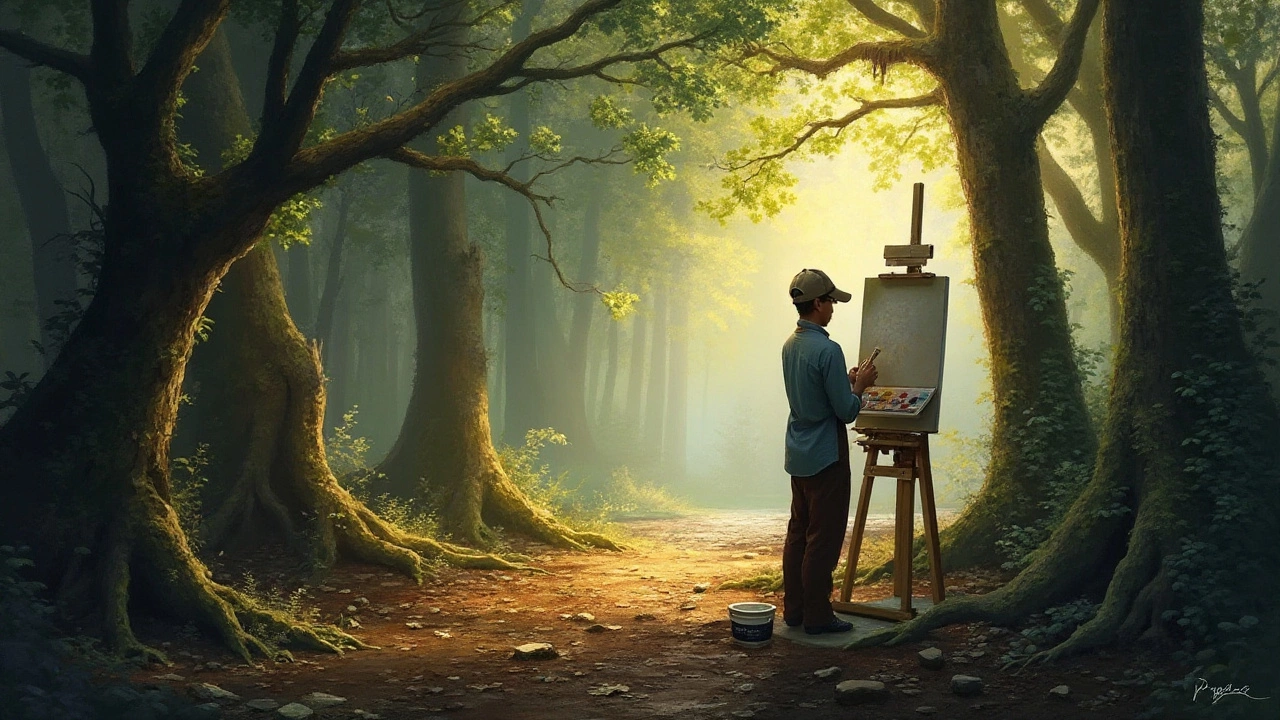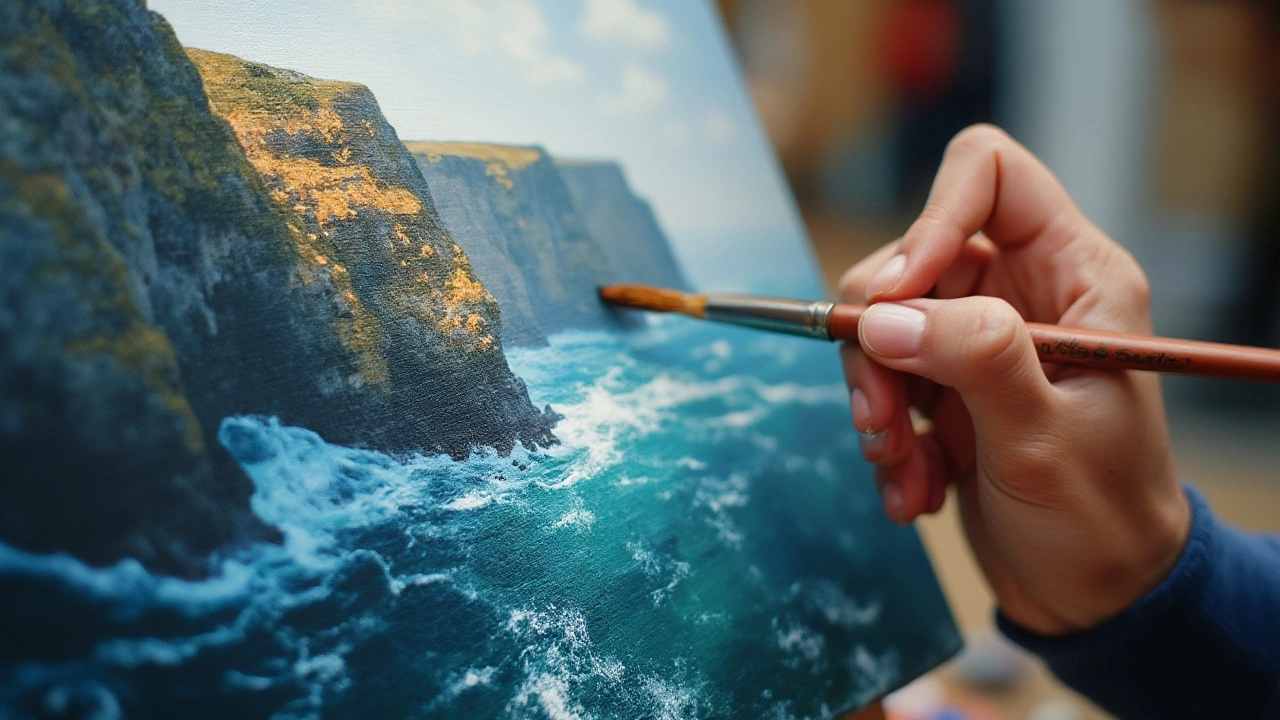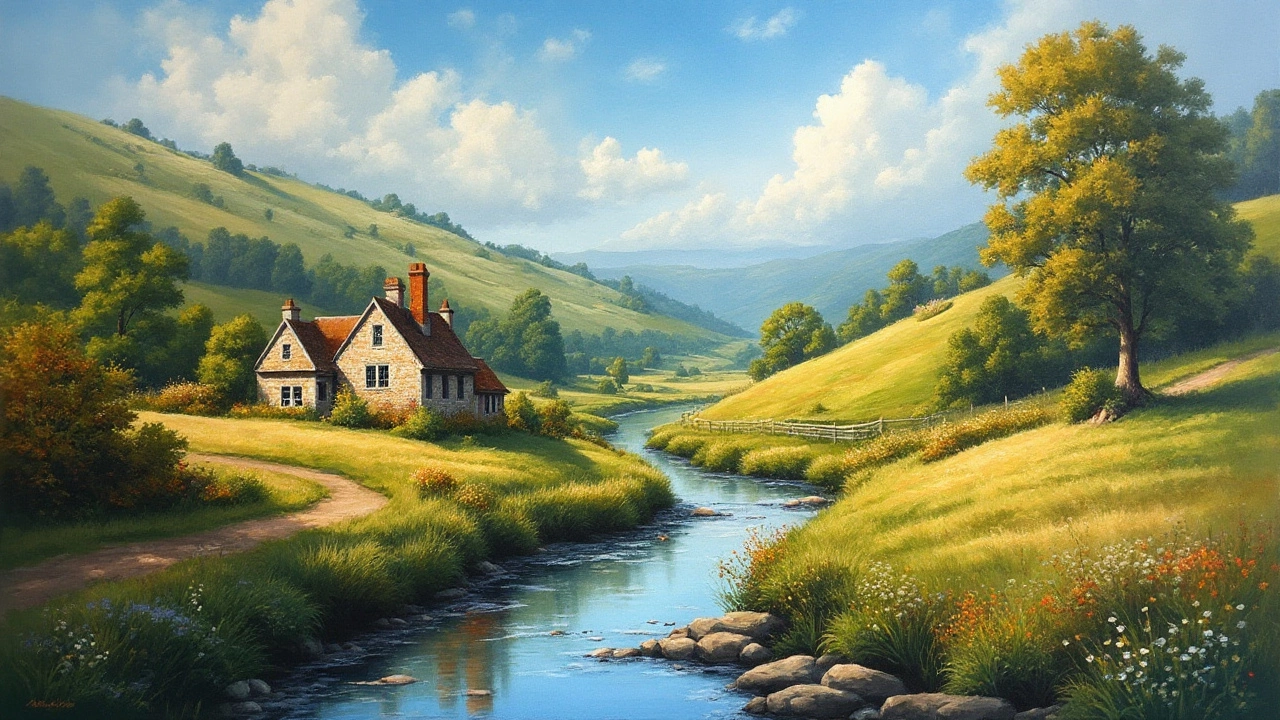Landscape painting is a timeless art form that invites us to capture the world around us in all its glorious detail. For aspiring artists, understanding the core components of landscape painting is crucial to creating works that resonate with viewers. From sweeping mountain vistas to serene lakeside scenes, the appeal lies in the balance and harmony within the composition.
In this exploration, we'll delve into the three major components of landscape painting: composition, color, and texture. These elements work in concert to convey mood, movement, and depth. Mastering them can transform a simple depiction of a scenic view into an evocative narrative that speaks to the soul.
Come along as we embark on this artistic journey, unveiling interesting facts and tips that can inspire both beginners and seasoned painters to elevate their craft.
- Understanding Composition
- The Role of Color
- Importance of Texture
- Tips for Beginners
- Inspirational Masterpieces
Understanding Composition
When embarking on the journey of landscape painting, one of the foundational elements to grasp is composition. It acts as the blueprint for your artwork, directing where the viewer's eye travels and how the story of your scene unfolds on the canvas. At its core, composition in painting refers to the arrangement of visual elements to create a coherent and balanced whole. This balance can be achieved through various techniques and principles, such as the rule of thirds, leading lines, and focal points, each playing a pivotal role in making a piece both dynamic and harmonious.
To start, consider the rule of thirds, a guideline artists have cherished for years. It involves dividing your canvas into nine equal segments by two equally spaced horizontal lines and two equally spaced vertical lines, and positioning critical elements of your scene along these lines or their intersections. This trick guides the eye across the artwork naturally, just as the ancient Greeks employed in architecture and sculpture—it remains a testament to the timeless appeal of balance and movement.
Another useful tip is incorporating leading lines, a technique that helps draw attention to key parts of the painting. These lines, often found in nature as paths, rivers, or branches, act as visual guides leading the viewer's gaze through the landscape. They imbue a sense of journey and narrative progression, seamlessly connecting the foreground to the background. An adept placement of leading lines can infuse your work with life and motion, creating an allure that beckons viewers deeper into the scene.
The focal point is yet another vital component, functioning as the heart of your composition. It's where you want the viewer’s attention to rest. In crafting a suitable focal point, consider contrast in color, texture, or size compared to its surroundings. Famous artists like Claude Monet often emphasized focal points through the use of light and shadow, giving depth and emphasis to the natural beauty depicted. A well-placed focal point lends a sense of purpose to your artwork, much like the gentle grandeur of a single sunlit tree amidst a sea of muted greenery.
As John Ruskin, a revered 19th-century art critic, once observed, "Composition is the art of arranging in a decorative manner the diverse elements at the painter's command to express his feelings." This melding of skill and emotion is what breathes life into the landscape.
Bear in mind that exploring negative space, too, can be incredibly effective. By skillfully using empty spaces, you allow the viewer's imagination to roam, enhancing the sense of vastness or solitude within your scene. It is, in essence, about understanding not only what to include but also what to exclude in your canvas, crafting a story that is as much about the silence between notes, to paraphrase music, as it is about the notes themselves.
Let's wrap up with a practical tip: sketch your composition lightly before committing paint to canvas. This way, you can experiment with different arrangements and perspectives without the permanence of paint. Such considerations in composition transform a landscape from a mere picture into an evocative tableau, inviting viewers into your artistic world.
The Role of Color
Color is one of the most striking elements in landscape painting, serving not only to reflect the environment's natural hues but also to evoke emotions and harmonize the composition. The palette chosen by an artist can dramatically alter the viewer's perception and mood of the painting. For instance, warm colors such as reds, oranges, and yellows often convey a sense of warmth and coziness, reminiscent of sunsets and autumn leaves. In contrast, cool colors like blues and greens can evoke feelings of calm, serenity, and sometimes melancholy. These colors help in creating various atmospheres that can transform a painting's emotional appeal entirely.
The utilization of color theory is essential in crafting a balanced painting. Understanding complementary colors—pairs of colors that, when combined, cancel out each other's hue to produce a grayscale color—is crucial in avoiding visual dissonance. For example, an artist might place vibrant yellows against deep violets to create contrast, drawing the spectator’s eye directly to the focal point of the landscape painting. Such techniques demonstrate how artists can manipulate color to guide the viewer's journey across the canvas.
The temperature of colors also plays a vital role. Warm colors are often associated with light and proximity, as they come forward in a picture, while cool colors tend to recede, suggesting distance and shadow. This is why many artists use warm hues in the foreground of a landscape painting and cooler tones in the background, creating the illusion of depth and distance. This layering enhances the painting's dimensionality, making it feel like an open window to another world.
Claude Monet, a renowned landscape painter, once said, "Color is my day-long obsession, joy, and torment."
His fascination with color helped define the Impressionist movement, where capturing light and its changing qualities was central. Monet's "Water Lilies" is an excellent example of using varied color palettes to convey different times of day and weather conditions, demonstrating how subtle color shifts can drastically alter the sensation of a scene.
An artist must also consider color harmony, which involves the pleasing arrangement of colors to create balance and visual appeal. The color wheel is an invaluable tool in achieving this harmony, helping artists identify analogous colors—those next to each other on the wheel—which often provide a serene and comfortable visual experience. This harmonious choice guides the flow from one part of the painting to another without abrupt changes or clashing hues, maintaining the viewer's engagement with the entire work.
Reflecting on the vividness of colors as represented in nature, artists often strive to replicate not just what they see but what they feel. This emotional translation through color can be enhanced by experimenting with techniques like glazing, where thin layers of translucent paint are added to intensify hues. Artists thereby enrich the painting with a luminous quality that paints a more profound connection with nature.
Whether to denote the vibrant energy of a bustling dawn, the quietude of twilight, or the ominous build-up of a storm, color remains integral in shaping the narrative of landscape paintings. Mastering its use requires both technical skill and an emotional intuition that comes from observing and connecting deeply with the environment.

Importance of Texture
Texture in landscape painting is akin to the tactile sensation you feel when touching the bark of a tree or running your fingers through a field of grass. In the realm of painting, texture is about creating the illusion of these sensations through visual means. Texture adds depth and realism that can transform a flat image into a lifelike representation. Often, artists use a variety of techniques and tools, such as palette knives and brushes of different sizes, to achieve this effect.
Artists striving to capture the essence of nature must consider how different textures evoke different emotions and responses. For instance, the rough texture of a craggy mountain peak conveys strength and durability, while the soft undulations of a distant meadow suggest peace and tranquility. This distinction allows viewers to not just see a painting, but feel the environment depicted. Historically, masters like Vincent Van Gogh employed bold brushstrokes and thick applications of paint, known as impasto, to impart incredible texture in their works. His renowned painting, "Starry Night," is an excellent example where texture plays a pivotal role in evoking emotion.
An interesting fact to note is how technology has influenced texture in modern painting. With the advent of digital art mediums, texture can now be simulated with remarkable authenticity. Yet, traditional artists still cherish the physicality of real materials and the unique capability of actual paint to capture light and shadow in a way digital sometimes fails to match. This enduring charm of paint has kept the tactile aspect of landscape painting alive and appreciated.
Techniques for Creating Texture
There are several techniques that artists can utilize to incorporate compelling textures in their art components. Using a dry brush technique allows artists to create rough effects that evoke the feel of dry wood or weathered rocks. On the other hand, a wet-on-wet technique enables the blending of colors before they dry, producing softer, more fluid textures that are perfect for depicting clouds or water. Experimenting with different tools and materials, such as adding sand to paint or using sponges, can also result in unique textures.
"Texture in painting is a bridge between two contrasting fields: reality and imagination." - Robert Bell
Creating texture requires a mindful balance between the desired emotional impact and the selected mediums. Whether utilizing thick globs of paint for an impasto look or subtle layering for a more muted effect, texture gives life to a landscape. It's this aspect that often endears a painting to an audience, drawing them in to explore every hill, valley, and shadow.
To sum it up, texture is an indispensable component of landscape painting, serving as a silent narrator that tells stories beyond what the eye can immediately see. By mastering this component, painters can invite viewers to step into a world that is not only visual but also emotionally enriching.
Tips for Beginners
Starting your journey in landscape painting can be both thrilling and daunting. Capturing the vastness of nature on a canvas is not just an artistic endeavor but an exploration of self-expression and interpretation of the world around us. For beginners, the key is to start with the basics and gradually build your skillset as you grow more comfortable with the medium. One of the first steps is to familiarize yourself with various tools and techniques. It's worth investing time in understanding different brushes and paints, as each combination can have a unique influence on your canvas. Consider experimenting with both watercolors and oils to grasp their respective qualities.
Many budding artists find inspiration in the outdoors, where shifting light and organic forms present endless creative opportunities. Start by choosing simple compositions—such as a single tree or a small hill—and focus on capturing these with precision. As you develop confidence, you can expand your subject matter to more complex scenes. Developing an EYE for detail and understanding the layers and structures within a landscape can elevate your painting from mere representation to something with depth and insight. In the words of the famous American painter Georgia O'Keeffe,
"Nobody sees a flower—really—it is so small it takes time—we haven't time—and to see takes time, like to have a friend takes time."
Join a community of artists, either locally or online. Sharing experiences and insights can provide valuable feedback and encouragement. Watching tutorials or taking a few classes can also considerably shorten your learning curve. Remember, practice is your best teacher, and each stroke paves the path to mastery. Engage in exercises that focus on key aspects of color and composition. Experiment with textures using palette knives or sponges to recreate the rugged climes of mountainous terrains or the softness of a field of daisies. Take note of the contrast between light and shadow, and how it transforms a seemingly mundane scene into one that evokes emotion and ambiance.
Useful Techniques for Starters
- Start with a quick sketch: Before laying down paint, sketch out the general composition to guide your initial layout.
- Emphasize on layers: Learn to paint in layers, as it allows you to rectify mistakes without starting over.
- Use a limited palette: Restrict the number of colors to focus on shades, tones, and dynamics, which can prevent overwhelming combinations.
- Embrace mistakes: Erroneous strokes offer learning and sometimes can lead to unexpectedly beautiful effects on your canvas.
- Maintain a journal: Keep an art journal for sketches and to note what worked or what didn’t. It provides a reference for your creative growth.
The art of visual arts is not constrained to just the depiction of reality; it's about reimagining the scene through your unique perspective. Your landscape might not look like the place it represents, but it can inspire a sense of space, light, and mood, much like the best paintings do. Don't be disheartened if your initial attempts don't look like Van Gogh's Starry Night or Monet's Water Lilies. Remember, these masters spent years refining their craft. Embrace patience, keep an open mind, and look at nature not just with your eyes, but with your heart.

Inspirational Masterpieces
Exploring the realm of landscape painting through the ages reveals a wealth of masterpieces that continue to captivate and inspire audiences and artists alike. One cannot overlook the profound influence of artists such as Claude Monet and his iconic series of Water Lilies, where the play of light and the subtle use of color create a symphony on canvas, drawing viewers into a dreamlike reflection of nature's beauty. Monet's ability to capture fleeting moments with an ethereal quality demonstrates the power of composition and color harmonizing to evoke emotion.
Another remarkable example is Vincent van Gogh's The Starry Night, a testament to the transformative potential of texture and vibrant color in artwork. This painting transcends the boundary between realism and emotion, showcasing swirling skies and luminous stars that invite the viewer into van Gogh’s inner world. His bold use of brushstrokes gives the landscape a dynamic, almost tactile quality that speaks to the unrest and beauty of the human spirit. Such works illustrate how the integration of all major components can turn simplicity into brilliance, a lesson for all aspiring landscape artists.
American painter Thomas Cole, recognized as a pivotal figure in the Hudson River School, significantly contributed to the evolution of landscape paintings in America during the 19th century. His work, The Oxbow, captures the expansive beauty of the American wilderness, juxtaposing the cultivated land with untamed nature. In this masterpiece, Cole masterfully uses detailed composition and a nuanced color palette to convey a subtle narrative about human intervention and natural beauty. The Oxbow serves as both an epic and intimate reflection of its time, offering a powerful message through its meticulous detail.
The enchanting landscapes of J.M.W. Turner, particularly pieces like The Fighting Temeraire, reveal a magnificence in transient light and atmosphere that few others achieved. Known for his innovative skills in conveying the ephemeral beauty of the sea and skies, Turner’s work transcends traditional landscapes by infusing them with emotional depth through color and light. His ability to depict nature in motion, with vigor yet delicate finesse, is truly inspirational, highlighting how understanding the elements of landscape painting opens limitless artistic possibilities.
Throughout history, many landscapes have stirred us deeply, etching an indelible mark on the tapestry of art. From the meticulous brushwork of traditional paintings to the bold explorations in color and form by modern artists, each masterpiece presents a unique fusion of artistic elements. These iconic works are not just paintings; they are timeless conversations with the viewer. Whether you're an artist seeking guidance or a viewer yearning for a deeper connection with art, let these masterpieces serve as your muse.

